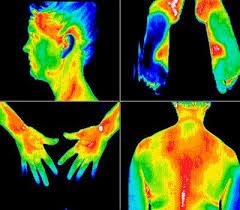
Thermography is a non-invasive, safe, technology that uses an infrared camera to capture pictures of the heat from the skin’s surface temperature without the use of radiation. The pictures help detect signs of injury or disease. It may also signal that injury or disease is at risk for developing in the future.
Prevention and early detection! Thermography is an excellent risk assessment tool that is non-invasive. Thermography can detect areas concern of developing pathology as well as pain that can lead to diagnoses such as those listed on the right.
Thermography is becoming a popular and appealing tool because of its safety and comfort. Thermography can also be used in younger women and those women with dense breast, which the mammogram has been shown to be less accurate.
Thermography is recommended to males and females of all ages. It is most appropriate to have baseline mammogram scan by the age of 25. Having a thermogram yearly after getting a baseline is strongly recommended as well as monthly self-breast exams. Picking up tissue changes when they begin allows you additional treatment time before the changes become problematic. Breast thermography is indicated regardless of age or breast size, who desire a painless and radiation-free risk assessment tool.
Breast thermography is a functional test, meaning it notes changes in breast tissue which may indicate abnormalities in cellular activity years before disease is present. In contrast, the mammogram is a structural test that must have a formed mass enough to be visualized. Like mammography and ultrasound, infrared imaging does not diagnose cancer, but merely indicates the presence of an abnormality. Only a tissue biopsy can actually diagnose cancer. The key benefit to thermography is that it can detect an abnormality far earlier, and may determine your risk for developing disease. If you have an abnormal thermogram, interventions can be taken immediately to prevent further growth and even normalize tissues.
The thermogram does not replace the mammogram. If abnormalities are detected on the thermogram, further testing will be strongly recommended by the radiologist and your health care provider.
Copyright © 2019-2023 Jolliffe Institute. All rights reserved. Privacy Policy | Return Policy. Website by KAT & Company.